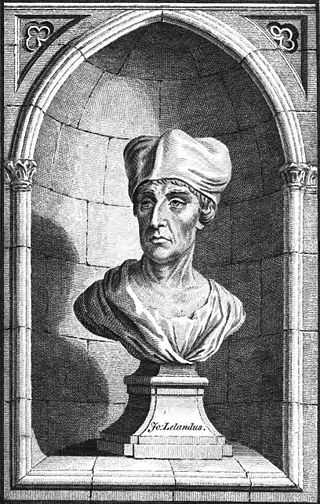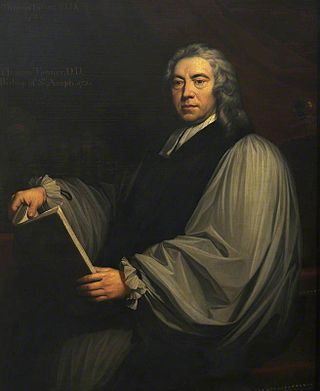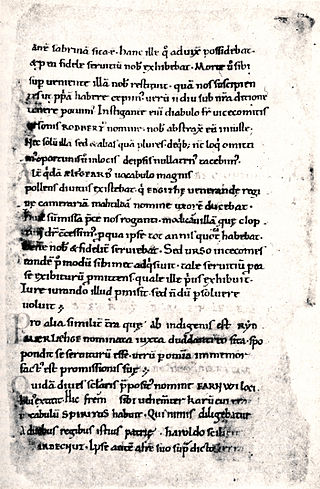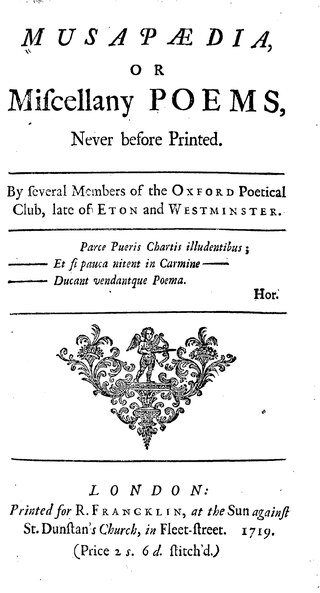Related Research Articles

The codex was the historical ancestor of the modern book. Instead of being composed of sheets of paper, it used sheets of vellum, papyrus, or other materials. The term codex is often used for ancient manuscript books, with handwritten contents. A codex, much like the modern book, is bound by stacking the pages and securing one set of edges by a variety of methods over the centuries, yet in a form analogous to modern bookbinding. Modern books are divided into paperback and those bound with stiff boards, called hardbacks. Elaborate historical bindings are called treasure bindings. At least in the Western world, the main alternative to the paged codex format for a long document was the continuous scroll, which was the dominant form of document in the ancient world. Some codices are continuously folded like a concertina, in particular the Maya codices and Aztec codices, which are actually long sheets of paper or animal skin folded into pages.

The Bodleian Library is the main research library of the University of Oxford, and is one of the oldest libraries in Europe. It derives its name from its founder, Sir Thomas Bodley. With over 13 million printed items, it is the second-largest library in Britain after the British Library. Under the Legal Deposit Libraries Act 2003, it is one of six legal deposit libraries for works published in the United Kingdom, and under Irish law it is entitled to request a copy of each book published in the Republic of Ireland. Known to Oxford scholars as "Bodley" or "the Bod", it operates principally as a reference library and, in general, documents may not be removed from the reading rooms.

John Leland or Leyland was an English poet and antiquary.

Thomas Tanner was an English antiquary and prelate. He was Bishop of St Asaph from 1732 to 1735.

Francis Douce was a British antiquary and museum curator.
W. de Wycombe was an English composer and copyist of the Medieval era. He was precentor of the priory of Leominster in Herefordshire. It is possible that he was the composer of one of the most famous tunes from medieval England, Sumer is icumen in.

Block books or blockbooks, also called xylographica, are short books of up to 50 leaves, block printed in Europe in the second half of the 15th century as woodcuts with blocks carved to include both text (usually) and illustrations. The content of the books was nearly always religious, aimed at a popular audience, and a few titles were often reprinted in several editions using new woodcuts. Although many had believed that block books preceded Gutenberg's invention of movable type in the first part of the 1450s, it now is accepted that most of the surviving block books were printed in the 1460s or later, and that the earliest surviving examples may date to about 1451.
Oxford, Bodleian Library, Rawlinson B 502 is a medieval Irish manuscript which presently resides in the Bodleian Library, Oxford. It ranks as one of the three major surviving Irish manuscripts to have been produced in pre-Norman Ireland, the two other works being the Lebor na hUidre and the Book of Leinster. Some scholars have also called it the Book of Glendalough, in Irish Lebar Glinne Dá Locha, after several allusions in medieval and early modern sources to a manuscript of that name. However, there is currently no agreement as to whether Rawlinson B 502, more precisely its second part, is to be identified as the manuscript referred to by that title.

Hemming's Cartulary is a manuscript cartulary, or collection of charters and other land records, collected by a monk named Hemming around the time of the Norman Conquest of England. The manuscript comprises two separate cartularies that were made at different times and later bound together; it is in the British Library as MS Cotton Tiberius A xiii. The first was composed at the end of the 10th or beginning of the 11th century. The second section was compiled by Hemming and was written around the end of the 11th or the beginning of the 12th century. The first section, traditionally titled the Liber Wigorniensis, is a collection of Anglo-Saxon charters and other land records, most of which are organized geographically. The second section, Hemming's Cartulary proper, combines charters and other land records with a narrative of deprivation of property owned by the church of Worcester.

Bookbinding is the process of building a book of codex manuscripts from an ordered stack of paper sheets with one's hands and tools. Firstly, one binds the sheets of papers along an edge with a thick needle and strong thread. One can also use loose-leaf rings, binding posts, twin-loop spine coils, plastic spiral coils, and plastic spine combs, but they last for a shorter time. Next, one encloses the bound stack of paper in a cover. Finally, one places an attractive cover onto the boards, and features the publisher's information and artistic decorations.
The Gesta Pontificum Anglorum, originally known as De Gestis Pontificum Anglorum and sometimes anglicized as The History or The Chronicle of the English Bishops, is an ecclesiastical history of England written by William of Malmesbury in the early 12th century. It covers the period from the arrival of St Augustine in AD 597 until the time it was written. Work on it was begun before Matilda's death in 1118 and the first version of the work was completed in about 1125. William drew upon extensive research, first-hand experience and a number of sources to produce the work. It is unusual for a medieval work of history, even compared to William's other works, in that its contents are so logically structured. The History of the English Bishops is one of the most important sources regarding the ecclesiastical history of England for the period after the death of Bede.

A miscellany is a collection of various pieces of writing by different authors. Meaning a mixture, medley, or assortment, a miscellany can include pieces on many subjects and in a variety of different forms. In contrast to anthologies, whose aim is to give a selective and canonical view of literature, miscellanies were produced for the entertainment of a contemporary audience and so instead emphasise collectiveness and popularity. Laura Mandell and Rita Raley state:
This last distinction is quite often visible in the basic categorical differences between anthologies on the one hand, and all other types of collections on the other, for it is in the one that we read poems of excellence, the "best of English poetry," and it is in the other that we read poems of interest. Out of the differences between a principle of selection and a principle of collection, then, comes a difference in aesthetic value, which is precisely what is at issue in the debates over the "proper" material for inclusion into the canon.

Drexel 4180–4185 is a set of six manuscript partbooks copied in Gloucester, England, containing primarily vocal music dating from approximately 1615-1625. Considered one of the most important sources for seventeenth century English secular song, the repertoire included represents a mixture of sacred and secular music, attesting to the partbooks' use for entertainment and pleasure, rather than exclusively for liturgical use.
The Peterhouse partbooks are a collection of English partbooks dating from the sixteenth and seventeenth centuries. They are named "Peterhouse" after Peterhouse in Cambridge, where the books were kept for some time, and are now preserved in the Cambridge University Library. They are handwritten manuscripts, all written on paper. At some point in the mid-eighteenth century, the books were rebound, although the foliation and indices remained unchanged.

Fragmentology is the study of surviving fragments of manuscripts. A manuscript fragment may consist of whole or partial leaves, typically made of parchment, conjugate pairs or sometimes gatherings of a parchment book or codex, or parts of single-leaf documents such as notarial acts. They are commonly found in book bindings, especially printed books from the 15th to the 17th centuries, used in a variety of ways such as wrappers or covers for the book, as endpapers, or cut into pieces and used to reinforce the binding. In other non-Western manuscript cultures, fragments of paper manuscripts and other materials, takes place beside parchment, including board covers that many times reused written paper.

Fragmentarium is an online database to collect and collate fragments of medieval manuscripts making them available to researchers, collectors and historians worldwide. It is an international collaboration of major libraries and collections including the British Library, Bibliothèque nationale de France, Martin Schøyen Collection, Bavarian State Library, Harvard, Yale and the Vatican. It is based in Switzerland and the project's current director is Professor Christoph Flüeler from the University of Fribourg and the Virtual Manuscript Library, Switzerland.

A Short English Chronicle is a chronicle produced in England in the first half of the 15th century. It is currently held in Lambeth Palace Library, and although it begins its coverage in 1189, its content is thin until it reaches 1422. It covers the years from then until 1464 in greater depth, ending with the marriage of the Yorkist King Edward IV to Elizabeth Woodville and the capture of the deposed Lancastrian King, Henry VI. It is one of a number of chronicles and writings emitting from London in the early 15th century, and it presents national political events from a London perspective.

The Selden Carol Book is a medieval carol manuscript held by the Bodleian Library in Oxford. Along with the Trinity Carol Roll, with which it shares five contemporaneous carols and texts, it is one of the main sources for 15th century English carols, and like the Trinity Roll contains the music as the well as the texts. The inclusion of Deo Gracias Anglia referencing Henry V's victory at Agincourt in 1415 gives an indication of the date of composition of the carols.
References
- ↑ Johansen, Jan Geir, The cohesion of the Worcester fragments , Papers on Language and Literature, Spring 1994.
- ↑ "Wycombe (Wicumbe, ?Whichbury, Winchecumbe), W. de" . Retrieved 29 February 2012.
- ↑ MS. Lat. liturg. d. 20: 15 original leaves of 'The Worcester Fragments' , Bodleian Library, University of Oxford, UK.